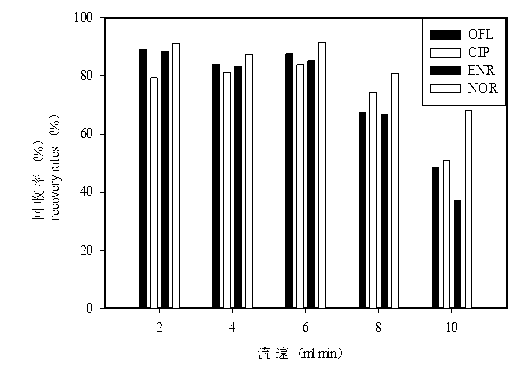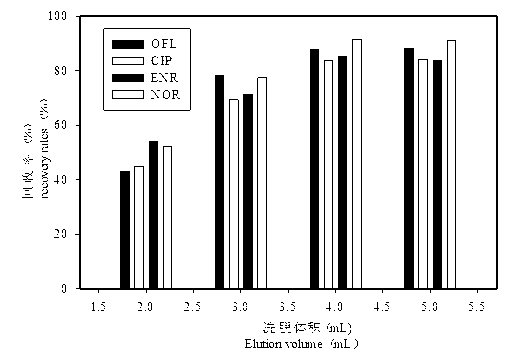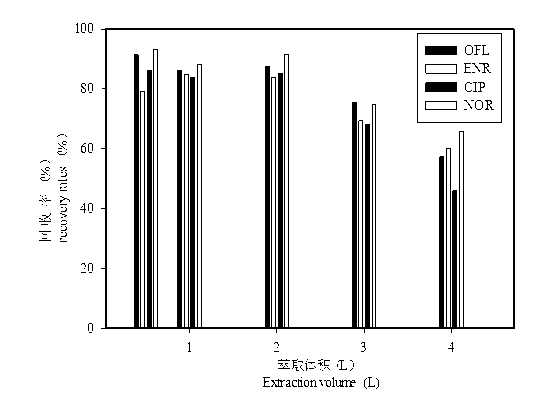Method for separation enrichment and detection of trace fluoroquinolone antibiotic in water environment
A technology for the separation and enrichment of fluoroquinolones, which is applied in the field of separation, enrichment and detection of trace fluoroquinolone antibiotic residues in the water environment. It can solve the problems of small differences in measurement results, low sensitivity, and poor specificity, and achieve low detection limited, good selectivity, and easy operation
- Summary
- Abstract
- Description
- Claims
- Application Information
AI Technical Summary
Problems solved by technology
Method used
Image
Examples
Embodiment 1
[0020] Embodiment 1: the selection of solid phase extraction conditions
[0021] 1. Activator selection:
[0022] Fluoroquinolone antibiotic substances are usually activated with methanol or acetonitrile. In the present invention, methanol was used for preliminary experiments. It was found that 2-4ml of methanol can well make the extraction column reach a completely wet state. In addition, in order to remove the interference of methanol remaining in the column to the enrichment process, the small column was rinsed with 2-4ml of water after activation with 2-4ml of methanol.
[0023] Second, the choice of eluent:
[0024] The function of washing is to remove the impurities on the solid phase extraction column under the premise that the filler retains the target, so as to further purify the target. For fluoroquinolone antibiotics, weakly acidic inorganic solvents are usually used. In the present invention, 5-8mL phosphoric acid (adjusting the pH to 3.0) + 5-8mL ultrapure water...
Embodiment 2
[0031] Accurately measure 2.0-4.0L water sample, let it stand and filter it through a 0.45μm mixed filter membrane for use; connect the supelco12 tube, solid phase extraction device, Oasis HLB extraction cartridge, buffer device and vacuum pump in order, and use 2- 4ml of methanol and 2-4ml of ultrapure water activate the small column in sequence, and connect it to the water sample through a large-capacity sampling tube; start the vacuum pump, adjust the vacuum pressure to control the extraction flow rate at 4.0-6.0mL / min, and wait until the water sample has completely passed through. After the column, rinse the column with 5-8mL phosphoric acid (adjust pH=3.0) and 5-8mL ultrapure water in sequence; then dry the column in vacuum (45°C) for 5-10min, elute with 2-4mL methanol, and elute The liquid was blown with nitrogen to below 1mL at 30°C, poured into an Agilent vial and then dilute to 1mL with methanol; add 0.5-1.0mL 100μg / L standard sarafloxacin solution as an internal stand...
Embodiment 3
[0032] Embodiment 3: the establishment of detection method
[0033] 1. Optimization of liquid phase conditions:
[0034] For mass spectrometers, it is forbidden to use phosphoric acid as the mobile phase; for quadrupole tandem time-of-flight mass spectrometers, triethylamine is strictly limited in the mobile phases allowed to enter; at the same time, the mobile phase flow rate of liquid mass spectrometry is also limited Much lower than pure liquid chromatography. Based on this, the liquid phase detection conditions in Table 1 were established.
[0035] Table 1 LC-MS / MS detection conditions
[0036]
[0037] Table 2 Mobile phase gradient settings
[0038] time / min B% 0 19 30 47 32 19
[0039] (Note: The final running time is 2 minutes)
[0040] 2. Optimization of mass spectrometry conditions:
[0041] The standard target mixture is detected and analyzed by liquid chromatography-mass spectrometer to determine the optimum crushing voltage va...
PUM
 Login to View More
Login to View More Abstract
Description
Claims
Application Information
 Login to View More
Login to View More - R&D
- Intellectual Property
- Life Sciences
- Materials
- Tech Scout
- Unparalleled Data Quality
- Higher Quality Content
- 60% Fewer Hallucinations
Browse by: Latest US Patents, China's latest patents, Technical Efficacy Thesaurus, Application Domain, Technology Topic, Popular Technical Reports.
© 2025 PatSnap. All rights reserved.Legal|Privacy policy|Modern Slavery Act Transparency Statement|Sitemap|About US| Contact US: help@patsnap.com



